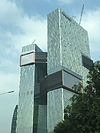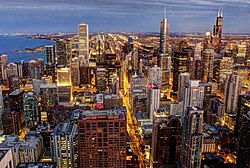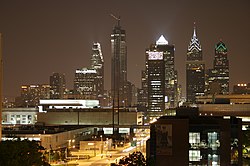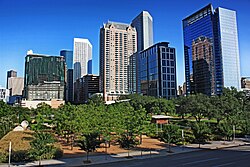Halland
This article is incomplete because it is pending further input from participants, or it is a work-in-progress by one author. Please comment on this article's talk page to share your input, comments and questions. Note: To contribute to this article, you may need to seek help from the author(s) of this page. |
Commonwealth of Halland Commonwealth of Halland Comhlathas na Tìr Hael | |
|---|---|
Motto: Sic semper tyrannis Thus always to tyrants | |
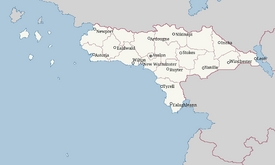 Political map of Halland | |
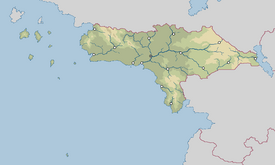 Physical map of Halland | |
| Capital | Avelon |
| Largest city | Astoria |
| Recognised national languages | Estmerish Ghailish |
| Recognised regional languages | Powhatan |
| Demonym(s) | Hallandic |
| Government | Unitary parliamentary republic |
• President | Arthur Quinn |
• Prime Minister | Sean Mac Dónaill |
| Senate | |
| National Assembly | |
| Establishment | |
• Colonisation by Estmere and Caldia | 1492 |
• Gilded Wars | 1721 |
• Independence from Gaullica | 1771 |
| Area | |
• | 1,831,549.44 km2 (707,165.19 sq mi) |
| Population | |
• 2015 census | |
| GDP (PPP) | 2019 estimate |
• Total | |
• Per capita | |
| GDP (nominal) | 2019 estimate |
• Total | |
• Per capita | |
| Gini (2015) | medium |
| HDI (2015) | very high |
| Currency | Pound (HLP) |
| Date format | dd.mm.yyyy |
| Driving side | right |
| Internet TLD | .hl |
Halland is a country in Asteria Superior, bordered by Cassier in the north, Nuxica in the south and the Vehemens Ocean to the west. It also shares a lake border with Chervolesia. The country is subdivided in 19 administrative regions, which cover an area of 1,831,549.44 square kilometers, making it the fifth largest state in Asteria. Halland is a unitary parliamentary republic with its capital in Avelon. Its largest city and main commercial center is Astoria, located on the northern coast of the nation. Other major cities include Ealaghleann, Stokes and Leon. Estmerish is the official language, although in the Fáel region, ghailish enjoys co-official status.
Indigenous Powhatan people inhabited the country for thousands of years prior to colonization. Assim Asteris and his expedition sponsored by Caldia discovered the continent in 1488, marking the beginning of colonization of the region by Euclean nations. Caldia soon after created its colony, Fáel, in the south of Halland. Soon after, Estmere established the colony of New Estmere to the north. Both colonies would grow prosperous, with the city of Astoria becoming a major port in the continent in the 17th century. Both colonies would be conquered by Gaullicia during the Gilded Wars of 1721. The new administration sponsored many policies which sparkled significant unrest, leading to various failed independence attempts and culminating in the 1764 War of Independence. Since then, Halland grew economically and became an important power in Asteria Superior, industrializing rapidly in the early 19th century and receiving many migrants. Halland was an important player in the Great War, achieving significant naval victories against Gaullica and aiding on the liberation of Nuxica.
In modern times Halland is a cosmopolitan nation with populations of a very diverse background. It is the fourth largest economy in the world by nominal GDP and the largest economy in Asteria. The nation has a significant international presence, being host of the Organization of Asterian Nations, one of the founding members of the CN, an observer member in COMSED and one of the founders of the ICD. Halland is considered a developed nation, with high standards of living and an advanced economy.
History
Pre-colonial era
Estmerish and Caldish colonization
Gaullican Administration
Independence and expansion
Industrialization and the Great War
Contemporary Era
Geography
Climate
Biodiversity
Urbanisation
Politics
Government

|
File:Official Portrait of Kentucky Governor Andy Beshear (cropped).jpg |
| Arthur Quinn President since 2016 |
Sean Mac Dónaill Prime Minister since 2018 |
Halland is a unitary parliamentary republic with a very strong democratic tradition since its foundation. Despite being a unitary state, Halland features significant levels of devolution, with regions enjoying varying levels of autonomy. The most notable of which is the Fáel region, which has a parliament of its own and devolution of significant powers under said parliament.
The nation's legislative power is a bicameral legislature, composed of the Senate and the National Assembly is responsible for approving national law, ratifying treaties, approving the yearly national expenditure and declaring war. The legislature also has power of Impeachment, as well as appointing a Prime Minister, who is the country's Head of Government.
Executive power is divided between the President, who is Head of State. and Prime Minister. While most executive power is exercised by the Prime Minister through appointed Ministers, the President is Commander-in-chief of the Armed Forces, can veto legislative proposals before they become law, and represents the country diplomatically in international summits and events.
The Judiciary is represented in its highest level by the Supreme Court and its lower instances. Ministers of the Supreme Court are appointed by the President, and are responsible for interpreting laws and their rulings are binding upon all lower courts. They also hold the power of retrial and can also reject laws considered unconstitutional. It is composed of 9 Ministers. Other than the Supreme Court, the Fáel Region also has the Superior Court of Fáel, which acts an intermediate court instance between conventional judicial instances and the Supreme Court. Regarding laws approved by the Parliament of Fáel, it also is not subject to further review by the Supreme Court.
Halland's Lower House, the National Assembly, is composed of 639 seats, which are elected to serve for 4 years. Elections for the National Assembly are done through Proportional Representation, where each of the 19 administrative regions are granted a seat per 100,000 inhabitants. The Senate has 76 voting members, with four senator seats given to each administrative region. Senators are elected through Single Transferable Vote, where each voter may list four candidates in order of preference. Election terms for the Senate last 8 years, with half the Senate elected every four years. Presidential elections happen every four years, and an elected president may be reelected no more than once. The Prime Minister is not elected, instead being chosen from the coalition most likely to form majority.
Each of the 19 Administrative Regions feature varying levels of autonomy and different systems of organization based on the 1988 Statute of Devolution. The Fáel Region has a Parliament of its own, organized in an unicameral legislature. Since the statute of Devolution, all Administrative Regions have elections in place for Governors, which have varying degrees of autonomy. Halland's current constitution was approved in 1974, extending local autonomy and increasing the powers of the legislative over the executive. It has since then received several ammendments such as the aforementioned Statute of Devolution. Ammendments must be approved with a qualified majority by both National Assembly and Senate.
Halland's modern political environment is protagonized by four major political parties: The Union Party (UP), the Liberal Republicans (LR), the Social Democratic Party (SDP) and the Fáelian Conservative Union (FCU). The first three parties represent nation-wide movements and traditions of Conservatism, Liberalism and Social Democracy respectively. The FCU is predominant in the Fáel region, being largely assotiated with the Union Party at a national level. Recently, the Green Party has gained relevance, rising in representatives both in Halland's National Assembly and Senate. The Green Party has achieved its first prefecture in 2016, in Tyrell.
Devolved Administrations
As per the Statute of Devolution, Halland is divided in 19 administrative regions, each with their own particularities confirmed by referendum in each of those regions. Regions in Halland are divided in two major categories: Constituencies and Autonomous Councils. 16 Regions in Halland are Constituencies, while three are Autonomous Councils. Each autonomous council has its own statute of autonomy, ratified by their legislatures and Parliament. The three statues of autonomy are vastly different from another, tailored to the specific nature of each one.
All regions regardless of status have a unicameral legislature. For constituencies, the Regional Councils enjoy limited legislative capacity, with autonomy to legislate over affairs as long as it does not contradict the constitution or national law. Additionally, Regional Councils enjoy autonomy to chose from among them a chancellor, responsible for the management of the region. Region's are given autonomy in the management of affairs such as regional infrastructure and basic education. In Autonomous Councils, the legislatures have much more autonomy and depending on the statute of autonomy may range from shared administration and division of responsibilities with the national government to full control of most government responsibilities.
Fáel, the largest Autonomous Council and also the Region enjoying the most autonomy, has its own Parliament with full legislative capacity within the Hallandic Constitution, police force, coast guard, superior court of justice as well as a much wider control over the region's own budget. The state still has control over significant assets in the Region, such as the National Health Service, the National Rail and Highways, Energy Generation and Defence. Other Autonomous Councils, such as the Assimians and St. Ellen Region, have increased legislative autonomy but still share much of their control with the State. Greater Avelon, which is an Autonomous Council, operates under a different legislature, with the executive elected directly and having much more power. The Governor of Greater Avelon works with the Council of Mayors of the various districts in Avelon, as well as the Region's City Council. The Regional City Council has a Council President which is responsible for the running of the council, and the body may enact laws in a level of autonomy not too unlike a regular constituency.
Law
Foreign Relations
Military
Economy
Halland is the largest economy in the Asterias, with a nominal GDP of $2.65 trillion. It is ranked the 4th largest economy in the world by nominal GDP and the 6th largest by Purchasing Power Parity. Private enterprise is extensive, with the nation being amongst the freest to do business with in Asteria. It has an unemployment rate of 4.7% and enjoys high labour productivity. Halland's development is centered along its coast, with Astoria being a notable global city.
Halland's economic growth has been steady ever since the 2005 crisis, with the country's economy growing by 3.6% in 2019, the largest growth since 2008. Halland is one of the largest importers of goods in Asteria, and the second largest exporter of goods in the continent. The nation has an extensive network of free trade agreements with the EC, Valentir, COMSED and other nations, as well as being one of the founding members of the Pan-Asterian Treaty for Cooperation and Defence, which also created a free-trade zone between Halland, Nuxica and Cassier.
Halland was the first nation to industrialize in Asteria, with the country achieving impressive economic growth and expansion following its independence from Gaullica. Astoria grew significantly and became an important industrial hub worldwide, and later so did Ealaghleann. The interior took longer to develop, with the government incentivizing an extensive rail network to connect the develop coast with the more rural interior. Stokes and later Leon have since then grown to become important development nodes in the hinterlands. Recent history has seen particular growth of population in the country's interior, due to reduced cost of living and availability of jobs. As a result, economic activity in the interior has increased significantly over the past decades.
Financial services are a significant sector of the economy, with the Astorian Stock Exchange being the largest in Asteria and one of the largest in the world. The services sector accounts for 70.9% of the economy, while the industrial sector composes 28.2% and agriculture 0.9% of GDP. Halland remains an industrial nation, although the country is deindustrializing at a fast rate in base industry. The automotive, electronic, naval, chemical and airspace industries are potent in Halland, being one of the most competitive in the world. The government owns significant shares in the airspace, energy and infrastructure sectors, with the country being considered by some to be a mixed economy. Recently, the government has been selling shares in several sectors of the economy, most notably the full privatization of HALCHEM, the country's largest petrochemical company, of which the government previously owned 40%, and the privatization of Hallair, the country's former nationally owned airline.
The government remains the leading employer in Halland, with 20.4% of employees working for the public sector. Labour movements in Halland are significant, with 64% of workers being unionized. As a result, worker's rights movements and negotiations are frequent. By law, Hallandic workers have one month paid vacation, guaranteed sick leave, extensive safety regulations, and a variety of other rights.
Halland is an exporter of agricultural products such as corn and wheat, with the country's food industry known worldwide. Halland is known for a diverse and internationally recognized varieties of cheeses, beers and cured meats. Beers, particularly of the Asterian Golden Ale and Asterian Wheat Beer are heavily exported, while internally different local varieties are consumed depending on region. Halland is known for its soft cow and goat milk cheeses, which have grown in popularity over the past decades. Hallandic Whiskey is also a significant luxury item exported worldwide.
Companies
Of |the world's 500 largest companies, 31 are housed in Halland. Halland's biggest companies maintain key roles in the insurance and banking industries, as well as the chemical and pharmaceutical sectors. The airspace sector is also one of the most competitive in the world. Halland is one of the easiest nations in the world to create a business in, with average time to create a company being only 4 days. The nation has an extensive small business and startups sponsoring programs, which have thus far created 13 Unicorn companies.
This list shows the 5 largest companies in Halland, as per their revenues reported in 2019.
Energy and Infrastructure
Tourism
Science and Technology
Demographics
| Largest urban centers by population | |||||||
|---|---|---|---|---|---|---|---|
| # | Settlement | Population | # | Settlement | Population |
| |
| 1 | Astoria | 5,412,716 | 11 | Ealdwald | TBD | ||
| 2 | Ealaghleann | 3,243,217 | 12 | Ruyter | TBD | ||
| 3 | Avelon | 2,955,910 | 13 | Winchester | TBD | ||
| 4 | Stokes | 2,313,102 | 14 | Wilton | TBD | ||
| 5 | Leon | 1,915,851 | 15 | Inoka | TBD | ||
| 6 | Tyrell | 1,404,460 | 16 | Nikinapi | TBD | ||
| 7 | Ardougne | 1,092,081 | 17 | Ailynn | TBD | ||
| 8 | New Warminster | 908,922 | 18 | Beaver | TBD | ||
| 9 | Yanille | 815,504 | 19 | Fort Kellsen | TBD | ||
| 10 | Newport | 783,408 | 20 | Kitigan | TBD | ||






